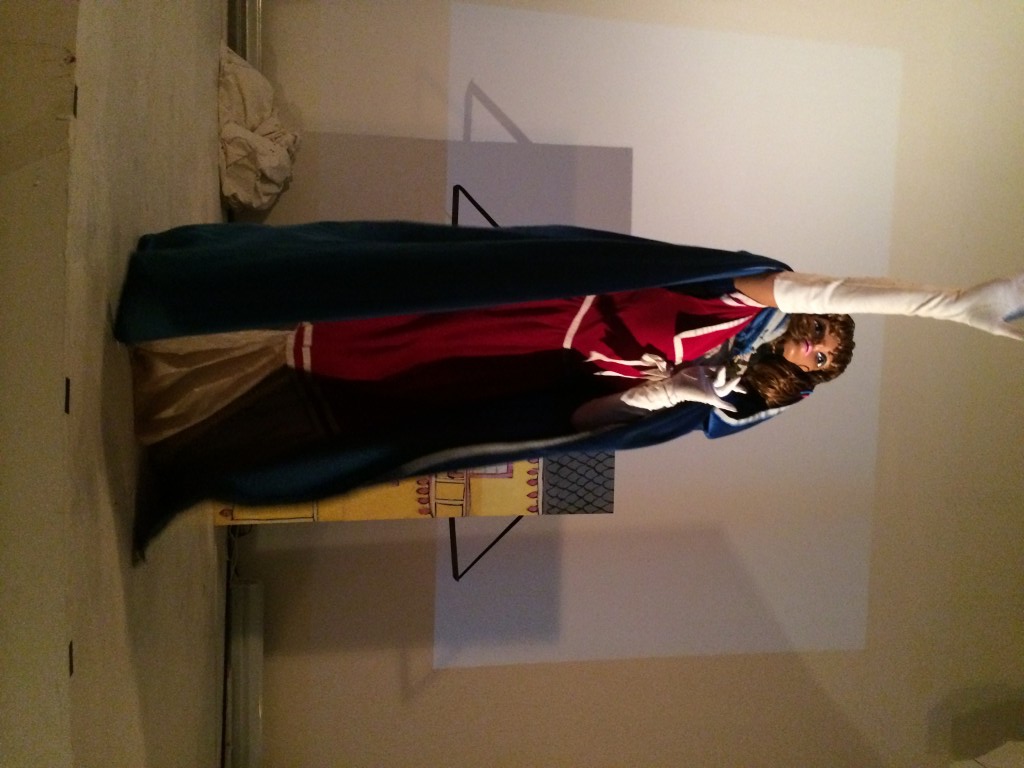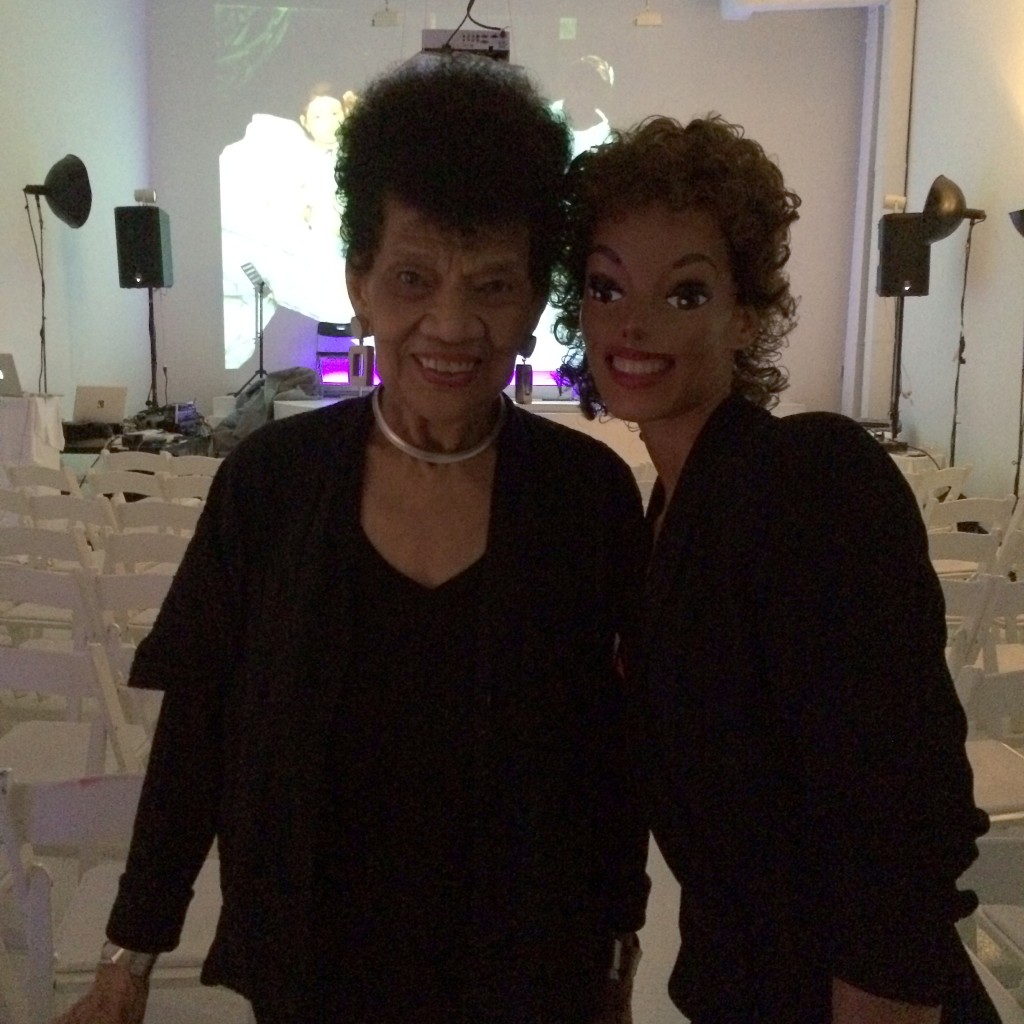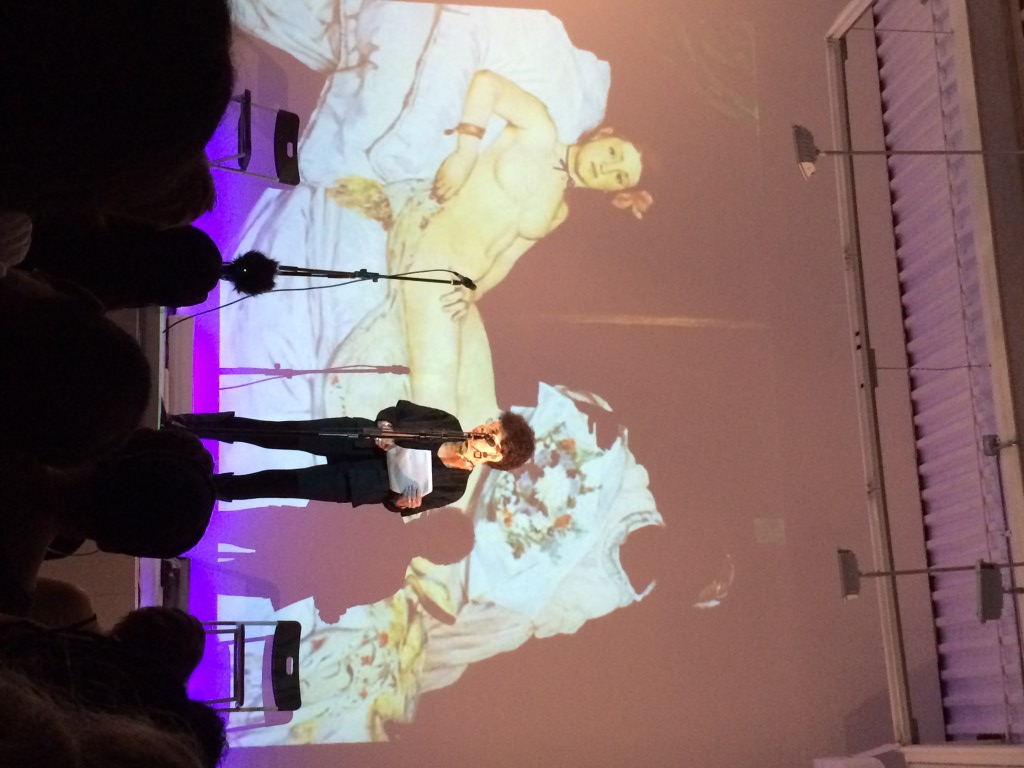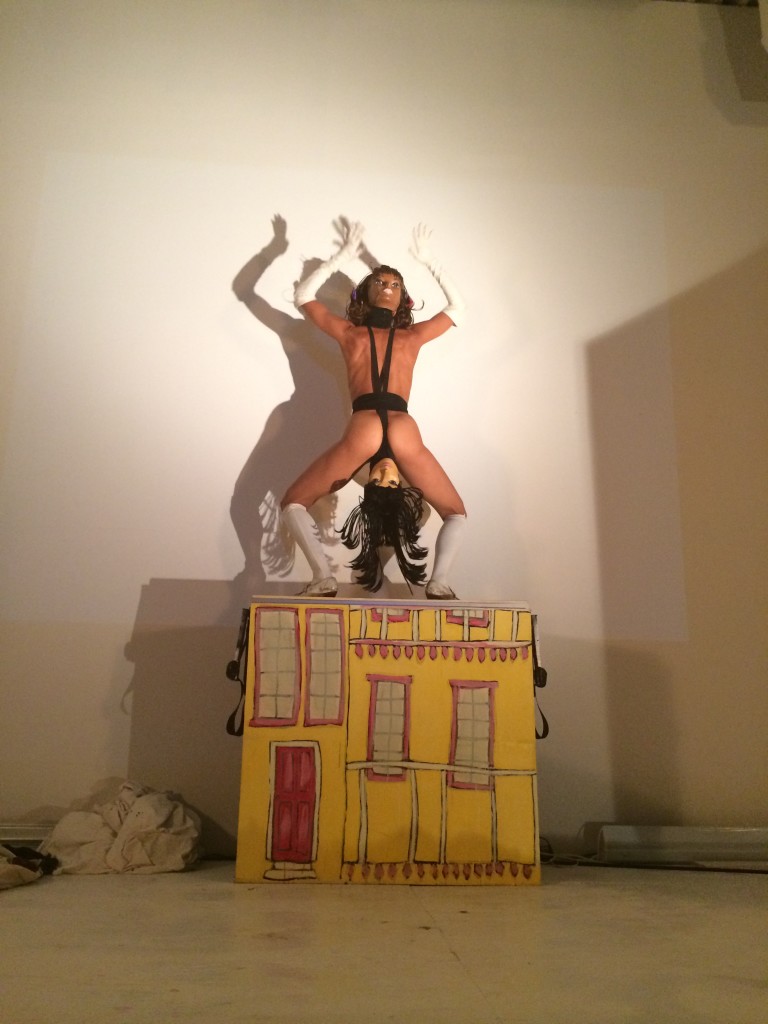Author | Katie Cercone
Photography by Elisa Garcia de la Herta
This past Sunday at the Hole Gallery, the Future Feminism Exhibition lionized artist Lorraine O’Grady by honoring the 20th anniversary of the publication of her seminal art historical text Olympia’s Maid: Reclaiming Black Female Subjectivity with a live reading by a collective of voices. Readers included art world notables such as Narcissister, Alice O’Malley, Xaviera Simmons, Ayana Evans, Martha Wilson, Ben Davis, Karen Finley and others. Following the reading, everyone shared a frosted cake in honor of O’Grady’s 80th Birthday.
A powerful and poignant essay in itself, the live recitation of Olympia’s Maid reminded all those in attendance that whatever crumbs of intersectional feminism are finally and haphazardly surfacing today in mainstream journalism certainly trace back to the clarion call O’Grady made when she emerged on the New York City art scene as a critic and performer over thirty years ago. Not only did Lorraine O’Grady rock the tepid and shallow waters of the art world back in the 80s with her art-critical persona Mlle Bourgeoise Noire, she was also the only person qualified and bold enough to write her renegade work into the official canon.
Born in the United States to parents of Caribbean Jamaican origin, O’Grady always maintained a radical eclecticism and critical distance from art world politics in her work. Come 1992, she would jet-rocket the artistic canon up to speed with her publication of Olympia’s Maid: Reclaiming Black Female Subjectivity, the first ever comprehensive article of art criticism on black female subjectivity and the black female body.
Exploring race, class and social identity, O’Grady’s work over the years has dealt head on with issues of miscegenation, cultural appropriation, the politics of black subversive style and black female agency. It was Lorraine, during a PERFORMA panel I attended several years ago, who schooled a young feminist like myself on the cat o’ nine tails, a 9-pronged implement used to whip blacks during slavery. In that very same lecture, she argued why Michael Jackson was the last real Modernist. It was Lorraine, during a panel on Feminism and Popular Music at the Soho20 gallery (O’Grady was also formerly a rock critic for Rolling Stone), who publicly thanked Eleanor Antin for doing her blackface ballerina performance, saying, it was the moment she knew that she (as a black woman) had to make art. Fast forward to 2014, where we witnessed O’Grady’s text read at the Hole by a large group that included successful contemporary black female artists, it’s clear that her germinal text paved the way for many.
 “The female body in the west is not a unitary sign,” begins Olympia’s Maid, “Rather, like a coin, it has an obverse and a reverse: on the one side, it is white; on the other, not white, or, prototypically, black. The two bodies cannot be separated, nor can one body be understood in isolation from the other in the West’s metaphoric construction of “woman.” Olympia’s Maid cuts to the heart of truth when it claims that black bodies in visual culture function as chiaroscuro, a mirror casting the definition of whiteness in sharp relief. Digging deep into the West’s “theatre of sexual hierarchy,” O’Grady’s writing marked a huge shift toward “winning back the position of the questioning subject for the black female,” in the art world and society at large. In this particular text Lorraine also defends the idea that black women (coming out of civil rights) were the first official Feminists, alluding to how the white middle class feminism that still to this day falsely animates the word in the popular imagination was largely built on the success of two black revolutions.
“The female body in the west is not a unitary sign,” begins Olympia’s Maid, “Rather, like a coin, it has an obverse and a reverse: on the one side, it is white; on the other, not white, or, prototypically, black. The two bodies cannot be separated, nor can one body be understood in isolation from the other in the West’s metaphoric construction of “woman.” Olympia’s Maid cuts to the heart of truth when it claims that black bodies in visual culture function as chiaroscuro, a mirror casting the definition of whiteness in sharp relief. Digging deep into the West’s “theatre of sexual hierarchy,” O’Grady’s writing marked a huge shift toward “winning back the position of the questioning subject for the black female,” in the art world and society at large. In this particular text Lorraine also defends the idea that black women (coming out of civil rights) were the first official Feminists, alluding to how the white middle class feminism that still to this day falsely animates the word in the popular imagination was largely built on the success of two black revolutions.
In the work of Narcissister, who in addition to reading O’Grady’s text performed her solo work as part of the Hole’s Future Feminism series, one sees clear links to both O’Grady’s performance work and her seminal writing. Narcissister, the daughter of a Moroccan Jewish mother and African American father, always performs in a garish, Barbie-esque mask. Performing what the New York Times has termed “avant-porn,” Narcissister is able to metaphorically embody the shifting, double, “both/and” psychic space that O’Grady attributes to black folks navigating a white world in Olympia’s Maid. Drawing from modern dance, neo-burlesque, performance art, collage, sewing, craft and a wide range of traditionally “feminine arts” to construct her unique performative idiom, Narcissister of all contemporary artists best exemplifies Lorraine O’Grady’s shift toward black female as questioning, post-modern, diasporic subject.
As O’Grady situates the black female body in a white male economy, she is peripheral, necessarily invisible. She doubly serves as Jezebel and Mammy, “when we’re through with her inexhaustibly comforting breast, we can use her ceaselessly open cunt.” Narcissister, who has always wisely remained within and outside the commercial art market place, has in many ways brought to life Olympia’s Maid as the keystone of O’Grady’s work and scholarly discourse around the black female body. Whether performing as a huge, glittering and furry vagina in early work or pulling god knows what out of her own, Narcissister has garnered much attention for her work as she confronts, displaces, and obliterates various signifiers which still cling to the (black) female body in popular imagination. Narcissister is also the coronated queen of self-pleasure. Whatever queer heteroglossia of terms she adopts to seduce viewers – candy colored aerobic wear, black power Afro, self-gratifying exercise bike, junk food, cigarettes, weapons, mirrors, dynamite, Barbie dolls – her commitment to place herself and her own pleasure at center always and only prevails.
During Narcissister’s evening at the Hole during the 13 days of Future Feminism she performed her signature four-headed doll/house piece. In the video leading into the live performance, set against ghostly nursery music, we see Narcissister’s hands playing with a topsy-turvy doll at a dollhouse. A folk toy of reconstruction, topsy-turvy is a two-headed doll that is white on one end, and black on the other, fusing a white baby girl with a black mammy hidden under her skirt (and vice versa). As the piece leads into a live performance, we see Narcissister shed layers and layers of clothing and masks and guises as is her characteristic swag. When she finally emerges – perfectly poised in a handstand – she has become the four-headed being, doll, woman, medium, monster. She is the integrated self. In place of the genitals that have often spoken in her work hangs the topsy-turvy headed version of her lingering quadruple consciousness. Narcissister as muse, as mirror, as chiaroscuro, as four-headed monster… she is certainly, black female as questioning self.
Although on the surface her glittering spectacles and hyperreal antics might appear to say something along the lines of “look at me,” (as is generally the condition of black bodies performing race, class and gender for the entertainment of white audiences throughout history), I’d argue she is saying something more along the lines of “I see me. I am. I exist. I love myself.” As she revealed during her solo show at Envoy Enterprises in 2013, where I happened to note Ms. O’Grady sitting quietly in the audience, “Self-Love” is the simplified message of her work. As the artist demonstrated in a video tryptic projected in the Envoy basement in which people of all ages, sizes and races dawned the mask, “Narcissister is You.” Both triumphing and rejecting the “unitary conception” of self which Lorraine O’Grady identifies in her writing as a limited construction of white patriarchal capitalist society, Narcissister operates within and beyond meaning. She is swiveling, wheeling; a beguiling icon of a raceless, genderless, classless future feminism to come.
It’s interesting that artist Kembra Pfahler of the Future Feminists, a former student of O’Grady’s at the School of Visual Art and a friend of Narcissister, also uses the cunt as a primary symbol in her work. Kembra’s members of The Voluptuous Horror of Karen Black, likewise seem to serve the purpose of destabilizing normative categories of race, class and gender. Performing as naked ladies with blue, purple and magenta skin, huge matted hair, black teeth and venomous upward slanted eyes – the girls of Karen Black perform dark rituals which assert the vagina as a sacred symbol. Like Narcissister, Pfahler’s work reclaiming and resacralizing the female genitalia jives neatly with the 12th tenet of Future Feminism – Restoring the female archetype as central to creation – as is majestically engraved on one of the huge slabs of rose quartz in the main gallery.
 An endeavor or four artists calling themselves the Future Feminists (Antony Hegarty of Antony and the Johnsons, Johanna Constantine, CocoRosie members Sierra and Bianca Casady, and Kembra Pfahler), the celebrity attached to many of the organizers and the current upsurge of interest in feminism in the mainstream caused the show to receive an (to use the most feminist word I can think of) ungodly amount of press. Interestingly, the only real detractors seem to come from within the feminist art movement itself. Feminist artist and critic Mira Schor’s biting blog critique posed questions like “Anyone here heard of Mary Daly?” and seemed to suggest that the show was not inclusive enough or appropriately historically situated, and that the slickness of young celebrity feminism in the wake of Pussy Riot was a curious, naive hazard.
An endeavor or four artists calling themselves the Future Feminists (Antony Hegarty of Antony and the Johnsons, Johanna Constantine, CocoRosie members Sierra and Bianca Casady, and Kembra Pfahler), the celebrity attached to many of the organizers and the current upsurge of interest in feminism in the mainstream caused the show to receive an (to use the most feminist word I can think of) ungodly amount of press. Interestingly, the only real detractors seem to come from within the feminist art movement itself. Feminist artist and critic Mira Schor’s biting blog critique posed questions like “Anyone here heard of Mary Daly?” and seemed to suggest that the show was not inclusive enough or appropriately historically situated, and that the slickness of young celebrity feminism in the wake of Pussy Riot was a curious, naive hazard.
Lorraine O’Grady, speaking with the authority of a celebrated elder, seemed to clear much of the tension hanging in the air when she ended the evening Sunday with a speech that went something along the lines of, “We need all kinds of feminisms, we need all kinds of feminists, even Beyonce feminism.” There she stood as graceful and composed as ever at the age of 80, her tall stature now casting its own chiaroscuro against the backdrop of a huge projection of Manet’s Olympia’s Maid. She addressed the crowd, as I remember it. “Keep coming together. Keep going! We haven’t done enough.” Then she posed with Narcissister (who, in mask, looked disturbingly like Lorraine O’Grady) for a quick photo and we all ate cake together as the rose quartz enveloped us in its aura.


